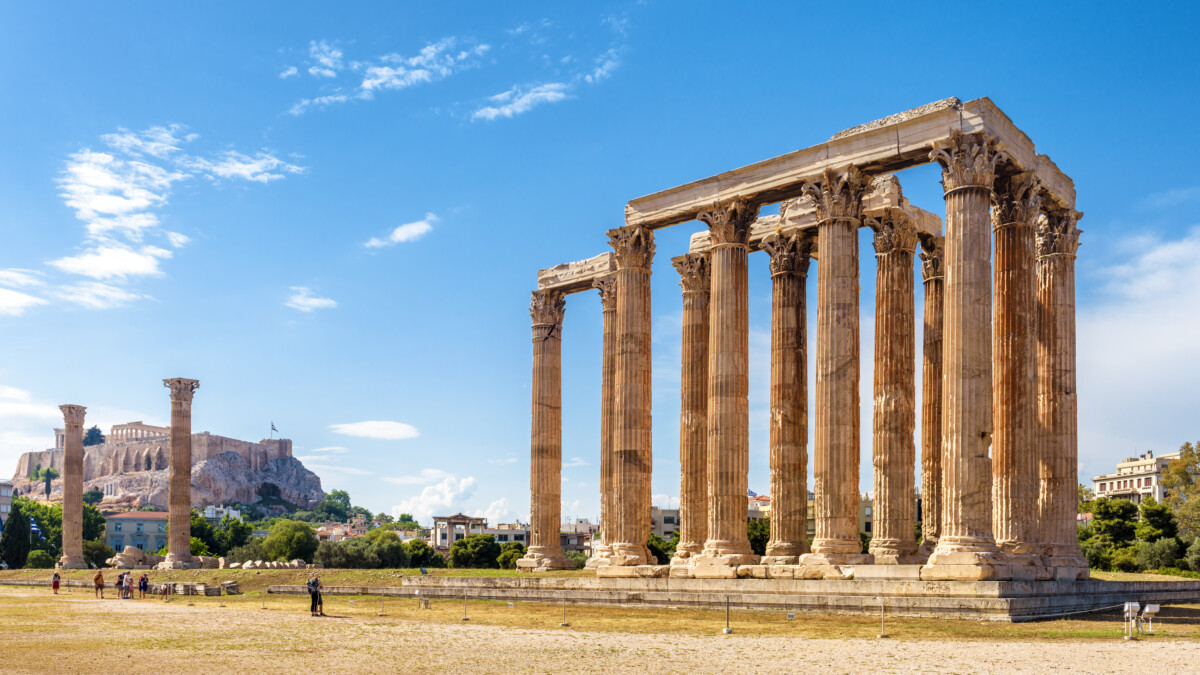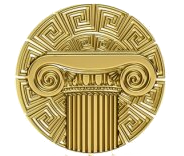
Das Olympieion (auch Tempel des Olympischen Zeus) in Athen war einer der größten Tempel im antiken Griechenland. Der Bau geht auf das 6. Jahrhundert v. Chr. zurück, wurde aber erst unter dem römischen Kaiser Hadrian im 2. Jahrhundert n. Chr. vollendet. Das Olympieion befindet sich rund 500 m östlich der Akropolis.
奥林匹亚宙斯神庙 (希腊语:Ναὸς τοῦ Ὀλυμπίου Διός, Naos tou Olympiou Dios), 又称Olympieion,是一座已毁的供奉宙斯的神庙,位于希腊首都雅典市中心,宪法广场以南700米,雅典卫城东南方500米。它始建于公元前6世纪,计划建成古代世界最伟大的寺庙,直到638年后,公元2世纪罗马帝国皇帝哈德良在位期间才得以完成。在罗马帝国时期,它是希腊最大的神庙,拥有古代世界最大的神像之一。
公元3世纪遭蛮族洗劫后,该庙被废弃。在罗马帝国灭亡后的数个世纪中,该庙的石料被大量取走,用于其他建筑的材料。今天仍可见到其遗迹,是雅典一个主要的旅游景点。
2007年1月21日,一群希腊多神教教徒在神庙举行崇拜宙斯的仪式。
The Temple of Olympian Zeus (Greek: Ναός του Ολυμπίου Διός, Naós tou Olympíou Diós), also known as the Olympieion or Columns of the Olympian Zeus, is a former colossal temple at the centre of the Greek capital Athens. It was dedicated to "Olympian" Zeus, a name originating from his position as head of the Olympian gods. Construction began in the 6th century BC during the rule of the Athenian tyrants, who envisaged building the greatest temple in the ancient world, but it was not completed until the reign of the Roman Emperor Hadrian in the 2nd century AD, some 638 years after the project had begun. During the Roman period the temple -that included 104 colossal columns- was renowned as the largest temple in Greece and housed one of the largest cult statues in the ancient world.
The temple's glory was short-lived, as it fell into disuse after being pillaged during a barbarian invasion in the 3rd century AD, just about a century after its completion. It was probably never repaired and was reduced to ruins thereafter. In the centuries after the fall of the Roman Empire, it was extensively quarried for building materials to supply building projects elsewhere in the city. Despite this, a substantial part of the temple remains today, notably sixteen of the original gigantic columns, and it continues to be part of a very important archaeological site of Greece.
L’Olympiéion (grec ancien : Ὀλυμπιεῖον), ou temple de Zeus olympien (grec ancien : Ναὸς τοῦ Ὀλυμπίου Διός), est situé au pied de l’Acropole d'Athènes. C’est un temple très vaste, d’ordre corinthien, dont il reste aujourd’hui 15 colonnes. Sa construction débuta au VIe siècle av. J.-C., et fut achevée par Hadrien en 131.
Il tempio di Zeus Olimpio (greco: Ναός του Ολυμπίου Διός) è un tempio situato ad Atene, in Grecia. Il tempio è situato a circa 500 metri dall'Acropoli e a circa 700 metri a sud del cuore di Atene, piazza Syntagma. Durante il periodo ellenistico ed il periodo romano è stato il tempio più grande della Grecia.
El templo de Zeus Olímpico, también conocido como el Olimpeion (griego Ναός του Ολυμπίου Διός, o Naos tou Olimpiou Dios), es un templo de Atenas. Aunque comenzado en el siglo VI a. C., no fue terminado hasta el reinado del emperador Adriano, en el siglo II. En las épocas helenística y romana era el templo más grande de Grecia.
ゼウス神殿またはオリュンピア=ゼウス神殿(ギリシア語: Ναὸς τοῦ Ὀλυμπίου Διός,ラテン語: Templum Iovis Olympii)は、ギリシャ、アテネのアクロポリスの東側にある神殿で、オリュンポス十二神の中の最高神であるゼウスに捧げられた神殿である。紀元前6世紀、僭主政のアテナイの時代に建設が始まったが、古代の世界で最大級であった神殿は完成させることがでなかった。神殿の完成は2世紀にローマ皇帝ハドリアヌスにより成し遂げられた。ローマ帝国期を通じて建てられた神殿の中で、この神殿は最大のものであった。
オリュンピア=ゼウス神殿またはオリュンピアのゼウス神殿の名前は、ハドリアヌスがつくらせた、金と象牙のゼウス像がオリュンピアのゼウス神殿にあったもののコピーであったことに由来する[1]。日本語でオリンピア=ゼウス神殿と表記されることもある。
L’Olympiéion (grec ancien : Ὀλυμπιεῖον), ou temple de Zeus olympien (grec ancien : Ναὸς τοῦ Ὀλυμπίου Διός), est situé au pied de l’Acropole d'Athènes. C’est un temple très vaste, d’ordre corinthien, dont il reste aujourd’hui 15 colonnes. Sa construction débuta au VIe siècle av. J.-C., et fut achevée par Hadrien en 131.
Le temple est situé au sud de l'Acropole, à environ 700 mètres du centre d'Athènes. Les fondations du premier temple remontent à -515, à l'époque de Pisistrate, mais le chantier s'est interrompu lorsque Hippias, fils de Pisistrate, fut ostracisé, en -510.
Durant la démocratie athénienne, le temple est resté inachevé, apparemment parce qu'il n'était pas dans l'esprit du temps de construire des bâtiments d'une telle ampleur. Dans sa Politique, Aristote le donne comme l'exemple de ce que les régimes tyranniques imposent inutilement à leurs populations. Les travaux ne reprennent qu'au IIIe siècle av. J.-C. avec la souveraineté macédonienne, et continuent sous le roi Antiochus IV Épiphane, qui charge l'architecte romain Decimus Cossutius de concevoir le plus grand temple du monde. Lorsque Antiochus meurt en -164, la construction du temple est à nouveau arrêtée.
En -86, Sylla, imposant à la Grèce la domination romaine, fit transporter au Capitole deux chapiteaux inachevés de l'Olympiéion, qui eurent une influence déterminante sur l'architecture romaine par l'adoption définitive de l'ordre corinthien dans toutes ses réalisations à venir.
Le temple ne fut achevé qu'en 129 (ou 131) apr. J.-C., sous l'impulsion de l'empereur Hadrien, grand admirateur de la culture grecque.
Il tempio di Zeus Olimpio (greco: Ναός του Ολυμπίου Διός) è un tempio situato ad Atene, in Grecia. Il tempio è situato a circa 500 metri dall'Acropoli e a circa 700 metri a sud del cuore di Atene, piazza Syntagma. Durante il periodo ellenistico ed il periodo romano è stato il tempio più grande della Grecia. Il tempio era costruito in marmo pentelico e misurava 108 metri in lunghezza e 41 in larghezza. Consisteva in 104 colonne corinzie, ognuna alta 17 metri. Solo 15 di queste colonne rimangono tuttora in piedi. La sedicesima colonna venne colpita da un fulmine durante un temporale nel 1852 e cadde sull'antica pavimentazione del tempio, dove è stata lasciata. Dell'imponente tempio rimangono, oltre alle colonne, il crepidoma e alcune porzioni dell'architrave tripartito.
El templo de Zeus Olímpico, también conocido como el Olimpeion (griego Ναός του Ολυμπίου Διός, o Naos tou Olimpiou Dios), es un templo de Atenas. Aunque comenzado en el siglo VI a. C., no fue terminado hasta el reinado del emperador Adriano, en el siglo II. En las épocas helenística y romana era el templo más grande de Grecia.
El templo se ubica a unos 500 metros al sureste de la Acrópolis de Atenas y a unos 700 m al sur de la Plaza Sintagma (centro de Atenas).
Sus cimientos fueron colocados en el sitio de un primer templo por el tirano Pisístrato en 515 a. C., pero el trabajo fue abandonado cuando su hijo, Hipias, fue derrocado en 510 a. C.1 Durante los años de la democracia ateniense, el templo fue dejado incompleto, porque se pensó que atentaba contra la hybris construir a tal escala. Aristóteles, en la Política, citó el templo como un ejemplo de cómo las tiranías atraían al pueblo a grandes obras de estado y lo dejaban sin tiempo, energía o medios para rebelarse.2
El trabajo fue reanudado en 174 a. C., durante la dominación macedonia de Grecia, bajo el patrocinio del rey helenístico Antíoco IV Epífanes, que contrató al arquitecto romano Cosucio para diseñar el templo más grande del mundo conocido. Cuando Antíoco murió en 164 a. C. el trabajo estaba retrasado otra vez.1
En 86 a. C., después de que las ciudades griegas cayeran bajo dominio romano, el general Sila llevó dos columnas del templo inacabado a Roma, para adornar el templo de Júpiter Capitolino en la colina Capitolina. Estas columnas influyeron en el desarrollo del estilo corintio en Roma.
En el siglo II, el templo fue retomado por el emperador Adriano, un gran admirador de la cultura griega, quien finalmente lo llevó a su conclusión en 129 (algunas fuentes dicen que en 131).1
No se sabe cuando fue destruido el edificio pero, como muchos edificios grandes de Grecia, es probable que fuera destruido por un terremoto en la Edad Media. La mayor parte de sus ruinas se usaron como materiales de construcción.
Олимпейо́н, храм Зевса Олимпийского (греч. Ναός του Ολυμπίου Διός) — самый большой храм Греции, строившийся с VI века до н. э. до II века н. э.; располагается в Афинах в 500 метрах к юго-востоку от Акрополя и около 700 метров южнее площади Синтагма.
Согласно легенде храм был построен на месте святилища мифического Девкалиона, праотца греческого народа.
Возведение храма было начато в период тирании Писистрата, в 515 г. до н. э. Афинская демократия интересовалась храмом мало, Фемистокл использовал его части для оборонительной стены, связавшей Афины с Пиреем (её раскопанный участок виден рядом с храмом).
В 175—164 гг. до н. э. строительство храма Зевса (уже в коринфском ордере) продолжил царь эллинистической Сирии Антиох IV Эпифан. В 84 году до н. э. римский диктатор Сулла снял с колонн несколько резных капителей и употребил их для строительства храма его римского аналога, Юпитера Капитолийского. Несмотря на это Тит Ливий почти столетие спустя называет афинский храм Зевса «единственным на свете, достойным этого божества».
Завершён храм был только через 650 лет после начала строительства, при римском императоре Адриане, поклоннике греческой культуры. Освящение нового храма, который Адриан посвятил Зевсу Олимпийскому, было приурочено ко второму визиту императора в Афины и стало центральным пунктом программы Всегреческих празднеств 132 г.
Храм был сильно повреждён во время нашествия герулов в 267 г. и едва ли восстанавливался после этого. После того как Феодосий запретил почитание языческих богов, элементы храма были использованы при строительстве церквей и домов.
В настоящее время от храма уцелел один угол, состоящий из 14 колонн, увенчанных коринфскими капителями, 2 отдельностоящие колонны и одна поваленная.




 History
History
 World Heritage
World Heritage
 Civilization
Civilization




